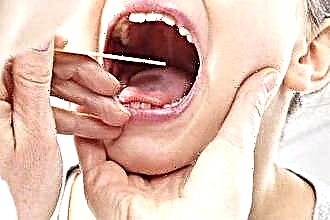Snot is generally an unpleasant phenomenon, but most people encounter it repeatedly throughout their lives. The appearance of snot usually serves as a signal for the onset of a cold or viral illness, less often as one of the symptoms of an allergic reaction. However, some find bloody snot in themselves in the morning and are very frightened, especially when this is repeated several times. Of course, it is not worth leaving this symptom unattended, but he also does not speak about serious malfunctions in the body.
Where does the blood come from
 As a matter of fact, there is simply no such term as "snot" in official medicine. This is a popular name for mucous discharge from the nose, which has entered into everyday life. When they become too profuse, then we are talking about such a symptom as a runny nose. The color of the discharge can even tell what triggered it. But where does the blood come from?
As a matter of fact, there is simply no such term as "snot" in official medicine. This is a popular name for mucous discharge from the nose, which has entered into everyday life. When they become too profuse, then we are talking about such a symptom as a runny nose. The color of the discharge can even tell what triggered it. But where does the blood come from?
The most common cause is rupture of small capillaries, of which there are a lot on the walls of the nasal passage. They are located under a thin mucous membrane and, with the least impact, can burst, leaving bloody marks visible when cleansing the nose. In the morning, blood is more noticeable, since it collects in the nasal cavity during the night and there are more small clots in the snot.
It is very important here not to confuse two completely different phenomena: rather harmless snot with blood in the morning and nosebleeds, which can also appear in the morning. It is very easy to distinguish them visually.
When blood in mucous secretions is present in the form of small clots or stains the snot in a slightly pinkish color, there is no cause for great concern. If, in the morning, scarlet or brown spots remain on the pillow, and when you blow your nose, red blood spreads on the napkin, this is already bleeding. If it continues, then you need to stop it, and then consult a doctor to find out the reason.
Causes of bleeding
 Damage and bleeding of capillaries, which results in a runny nose with blood in the morning, can cause many different reasons - from mechanical stress to various diseases, even not always associated with the respiratory system. Most likely, only a doctor can determine the exact cause. And we will consider only a few of the most common ones:
Damage and bleeding of capillaries, which results in a runny nose with blood in the morning, can cause many different reasons - from mechanical stress to various diseases, even not always associated with the respiratory system. Most likely, only a doctor can determine the exact cause. And we will consider only a few of the most common ones:
- Indoor air is too dry. Especially during the heating season, when the heaters are constantly on. Leads to drying out of the nasal mucosa. It becomes covered with small cracks and the capillaries simply break. A simple humidifier will help solve the problem. And if you can't buy it, try hanging a wet towel on the battery or placing a container of water near it.
- Vascular spasms. They are very often experienced by meteorological people. Also, a spasm can occur when the head is in the wrong position during sleep. If the pillow is too high or too low, the neck is in constant tension and blood circulation may be impaired. Sometimes vascular spasms occur with a sharp change in climate or overstrain. It is possible to deal with such a phenomenon only symptomatically by eliminating the provocative factors.
 Increased blood pressure or intracranial pressure. And this is already a dangerous symptom that should be paid special attention to. Usually it can be recognized by a fairly severe headache, which is accompanied by spotting. They can even serve as the beginning of nosebleeds, which are often the case with such diagnoses. If snot with blood appears constantly in the morning, and you often experience dizziness, pressing pain in the back of the head and / or temples, darkening or "stars" in the eyes - immediately consult a doctor. This may be the first symptom of a pre-stroke condition.
Increased blood pressure or intracranial pressure. And this is already a dangerous symptom that should be paid special attention to. Usually it can be recognized by a fairly severe headache, which is accompanied by spotting. They can even serve as the beginning of nosebleeds, which are often the case with such diagnoses. If snot with blood appears constantly in the morning, and you often experience dizziness, pressing pain in the back of the head and / or temples, darkening or "stars" in the eyes - immediately consult a doctor. This may be the first symptom of a pre-stroke condition.- Mechanical damage. It is very easy to damage the capillaries, even with too intensive cleansing of the nasal passages. Especially for those who like to poke around there with a finger or cotton swabs. Due to too much pressure, the thin walls are torn, and blood gets into the snot. Sometimes the bleeding occurs for some time after a serious injury or nose surgery. This suggests that the healing process of the wound surface has not yet been completed and measures must be taken to avoid infection and the development of inflammation.
- Viruses and infections. Dryness of the nasal mucosa causes a sharp increase in body temperature, which is usually accompanied by diseases provoked by pathogenic microorganisms. They also cause temporary thinning of the walls of the capillaries and their increased fragility. Overdry the mucous membrane and vasoconstrictor nasal drops, which are often prescribed for the common cold (especially drugs with prolonged action). You can solve the problem with oil-based drops (for example, "Pinosola") or lubricating the nasal passages with petroleum jelly or baby cream.
 Capillary fragility. It can be congenital or acquired. It is quite simple to determine it - in people with too thin capillaries, even after not very strong pressure or a light blow, a bruise appears on the body. In healthy people, increased fragility of capillaries can cause a banal vitamin deficiency, primarily a lack of vitamin C. Taking multivitamin preparations, giving up bad habits and a balanced diet will help restore their elasticity.
Capillary fragility. It can be congenital or acquired. It is quite simple to determine it - in people with too thin capillaries, even after not very strong pressure or a light blow, a bruise appears on the body. In healthy people, increased fragility of capillaries can cause a banal vitamin deficiency, primarily a lack of vitamin C. Taking multivitamin preparations, giving up bad habits and a balanced diet will help restore their elasticity.
It is important to understand that all of the above is true for transparent mucous secretions of medium density.
When the color of the snot is poisonous yellow, orange, brown or green, this is a signal of various diseases. And spotting is most likely their consequence. In this case, a high-quality diagnostic examination is necessary.
Preventive measures
If you notice snot with blood that appears more or less often in the morning and have established the cause of their appearance, you should think about preventive measures that will minimize the likelihood that after treatment they will return again. They should: strengthen the walls of capillaries and blood vessels, increase immunity and moisturize the nasal mucosa. Here's what you can easily do at home:
 with a runny nose, gently blow your nose, alternately blowing both nostrils;
with a runny nose, gently blow your nose, alternately blowing both nostrils;- do not exceed the recommended dosage of vasoconstrictor drugs;
- do not clean your nose with cotton swabs or other hard objects;
- at least 2-3 times a week, rinse the nostrils with saline (1 teaspoon per 100 ml of water), to which you can add 2-3 drops of iodine;
- twice a year (preferably in the off-season) take a course of multivitamin preparations;
- include in the diet the maximum amount of foods rich in vitamin C (citrus, sour berries, sweet peppers, parsley, rosehip broth);
- if there is a tendency to increase blood pressure, ensure its daily control and, if necessary, take antihypertensive drugs;
- do articulatory gymnastics, which improves blood circulation in the upper respiratory tract.
It is worth worrying if snot with blood appeared during pregnancy. They can signal that there has been a malfunction in the hormonal system. It is better for the mom-to-be to go to the doctor and make sure everything is in order.
For all the other preventive measures listed above, it will be quite enough so that you no longer worry about this.

 Increased blood pressure or intracranial pressure. And this is already a dangerous symptom that should be paid special attention to. Usually it can be recognized by a fairly severe headache, which is accompanied by spotting. They can even serve as the beginning of nosebleeds, which are often the case with such diagnoses. If snot with blood appears constantly in the morning, and you often experience dizziness, pressing pain in the back of the head and / or temples, darkening or "stars" in the eyes - immediately consult a doctor. This may be the first symptom of a pre-stroke condition.
Increased blood pressure or intracranial pressure. And this is already a dangerous symptom that should be paid special attention to. Usually it can be recognized by a fairly severe headache, which is accompanied by spotting. They can even serve as the beginning of nosebleeds, which are often the case with such diagnoses. If snot with blood appears constantly in the morning, and you often experience dizziness, pressing pain in the back of the head and / or temples, darkening or "stars" in the eyes - immediately consult a doctor. This may be the first symptom of a pre-stroke condition. Capillary fragility. It can be congenital or acquired. It is quite simple to determine it - in people with too thin capillaries, even after not very strong pressure or a light blow, a bruise appears on the body. In healthy people, increased fragility of capillaries can cause a banal vitamin deficiency, primarily a lack of vitamin C. Taking multivitamin preparations, giving up bad habits and a balanced diet will help restore their elasticity.
Capillary fragility. It can be congenital or acquired. It is quite simple to determine it - in people with too thin capillaries, even after not very strong pressure or a light blow, a bruise appears on the body. In healthy people, increased fragility of capillaries can cause a banal vitamin deficiency, primarily a lack of vitamin C. Taking multivitamin preparations, giving up bad habits and a balanced diet will help restore their elasticity. with a runny nose, gently blow your nose, alternately blowing both nostrils;
with a runny nose, gently blow your nose, alternately blowing both nostrils;

